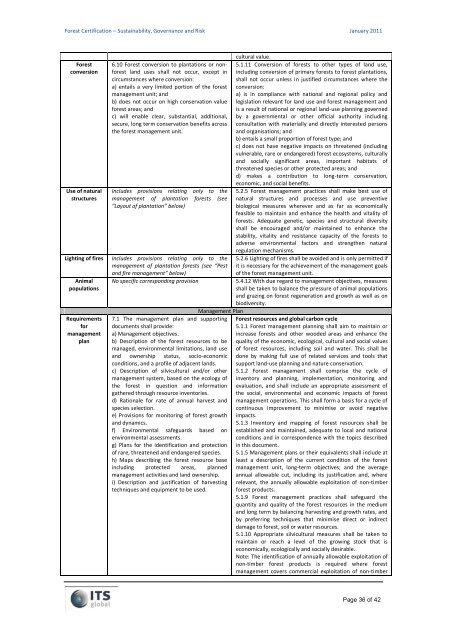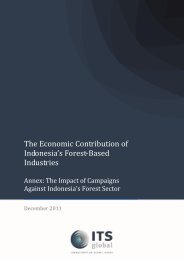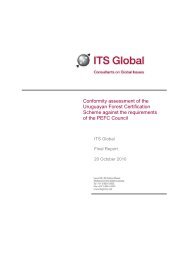Forest Certification â Sustainability, Governance and Risk - ITS Global
Forest Certification â Sustainability, Governance and Risk - ITS Global
Forest Certification â Sustainability, Governance and Risk - ITS Global
Create successful ePaper yourself
Turn your PDF publications into a flip-book with our unique Google optimized e-Paper software.
<strong>Forest</strong> <strong>Certification</strong> – <strong>Sustainability</strong>, <strong>Governance</strong> <strong>and</strong> <strong>Risk</strong> January 2011<br />
<strong>Forest</strong><br />
conversion<br />
Use of natural<br />
structures<br />
Lighting of fires Includes provisions relating only to the<br />
management of plantation forests (see “Pest<br />
Animal<br />
populations<br />
Requirements<br />
for<br />
management<br />
plan<br />
cultural value.<br />
6.10 <strong>Forest</strong> conversion to plantations or nonforest<br />
5.1.11 Conversion of forests to other types of l<strong>and</strong> use,<br />
l<strong>and</strong> uses shall not occur, except in including conversion of primary forests to forest plantations,<br />
circumstances where conversion:<br />
shall not occur unless in justified circumstances where the<br />
a) entails a very limited portion of the forest conversion:<br />
management unit; <strong>and</strong><br />
a) is in compliance with national <strong>and</strong> regional policy <strong>and</strong><br />
b) does not occur on high conservation value legislation relevant for l<strong>and</strong> use <strong>and</strong> forest management <strong>and</strong><br />
forest areas; <strong>and</strong><br />
is a result of national or regional l<strong>and</strong>-use planning governed<br />
c) will enable clear, substantial, additional, by a governmental or other official authority including<br />
secure, long term conservation benefits across consultation with materially <strong>and</strong> directly interested persons<br />
the forest management unit.<br />
<strong>and</strong> organisations; <strong>and</strong><br />
b) entails a small proportion of forest type; <strong>and</strong><br />
c) does not have negative impacts on threatened (including<br />
vulnerable, rare or endangered) forest ecosystems, culturally<br />
<strong>and</strong> socially significant areas, important habitats of<br />
threatened species or other protected areas; <strong>and</strong><br />
d) makes a contribution to long-term conservation,<br />
economic, <strong>and</strong> social benefits.<br />
Includes provisions relating only to the 5.2.5 <strong>Forest</strong> management practices shall make best use of<br />
management of plantation forests (see natural structures <strong>and</strong> processes <strong>and</strong> use preventive<br />
“Layout of plantation” below)<br />
biological measures wherever <strong>and</strong> as far as economically<br />
feasible to maintain <strong>and</strong> enhance the health <strong>and</strong> vitality of<br />
forests. Adequate genetic, species <strong>and</strong> structural diversity<br />
shall be encouraged <strong>and</strong>/or maintained to enhance the<br />
stability, vitality <strong>and</strong> resistance capacity of the forests to<br />
adverse environmental factors <strong>and</strong> strengthen natural<br />
regulation mechanisms.<br />
5.2.6 Lighting of fires shall be avoided <strong>and</strong> is only permitted if<br />
it is necessary for the achievement of the management goals<br />
<strong>and</strong> fire management” below)<br />
of the forest management unit.<br />
No specific corresponding provision<br />
5.4.12 With due regard to management objectives, measures<br />
shall be taken to balance the pressure of animal populations<br />
<strong>and</strong> grazing on forest regeneration <strong>and</strong> growth as well as on<br />
biodiversity.<br />
Management Plan<br />
7.1 The management plan <strong>and</strong> supporting<br />
documents shall provide:<br />
a) Management objectives.<br />
b) Description of the forest resources to be<br />
managed, environmental limitations, l<strong>and</strong> use<br />
<strong>and</strong> ownership status, socio-economic<br />
conditions, <strong>and</strong> a profile of adjacent l<strong>and</strong>s.<br />
c) Description of silvicultural <strong>and</strong>/or other<br />
management system, based on the ecology of<br />
the forest in question <strong>and</strong> information<br />
gathered through resource inventories.<br />
d) Rationale for rate of annual harvest <strong>and</strong><br />
species selection.<br />
e) Provisions for monitoring of forest growth<br />
<strong>and</strong> dynamics.<br />
f) Environmental safeguards based on<br />
environmental assessments.<br />
g) Plans for the identification <strong>and</strong> protection<br />
of rare, threatened <strong>and</strong> endangered species.<br />
h) Maps describing the forest resource base<br />
including protected areas, planned<br />
management activities <strong>and</strong> l<strong>and</strong> ownership.<br />
i) Description <strong>and</strong> justification of harvesting<br />
techniques <strong>and</strong> equipment to be used.<br />
<strong>Forest</strong> resources <strong>and</strong> global carbon cycle<br />
5.1.1 <strong>Forest</strong> management planning shall aim to maintain or<br />
increase forests <strong>and</strong> other wooded areas <strong>and</strong> enhance the<br />
quality of the economic, ecological, cultural <strong>and</strong> social values<br />
of forest resources, including soil <strong>and</strong> water. This shall be<br />
done by making full use of related services <strong>and</strong> tools that<br />
support l<strong>and</strong>-use planning <strong>and</strong> nature conservation.<br />
5.1.2 <strong>Forest</strong> management shall comprise the cycle of<br />
inventory <strong>and</strong> planning, implementation, monitoring <strong>and</strong><br />
evaluation, <strong>and</strong> shall include an appropriate assessment of<br />
the social, environmental <strong>and</strong> economic impacts of forest<br />
management operations. This shall form a basis for a cycle of<br />
continuous improvement to minimise or avoid negative<br />
impacts.<br />
5.1.3 Inventory <strong>and</strong> mapping of forest resources shall be<br />
established <strong>and</strong> maintained, adequate to local <strong>and</strong> national<br />
conditions <strong>and</strong> in correspondence with the topics described<br />
in this document.<br />
5.1.5 Management plans or their equivalents shall include at<br />
least a description of the current condition of the forest<br />
management unit, long-term objectives; <strong>and</strong> the average<br />
annual allowable cut, including its justification <strong>and</strong>, where<br />
relevant, the annually allowable exploitation of non-timber<br />
forest products.<br />
5.1.9 <strong>Forest</strong> management practices shall safeguard the<br />
quantity <strong>and</strong> quality of the forest resources in the medium<br />
<strong>and</strong> long term by balancing harvesting <strong>and</strong> growth rates, <strong>and</strong><br />
by preferring techniques that minimise direct or indirect<br />
damage to forest, soil or water resources.<br />
5.1.10 Appropriate silvicultural measures shall be taken to<br />
maintain or reach a level of the growing stock that is<br />
economically, ecologically <strong>and</strong> socially desirable.<br />
Note: The identification of annually allowable exploitation of<br />
non-timber forest products is required where forest<br />
management covers commercial exploitation of non-timber<br />
Page 36 of 42




